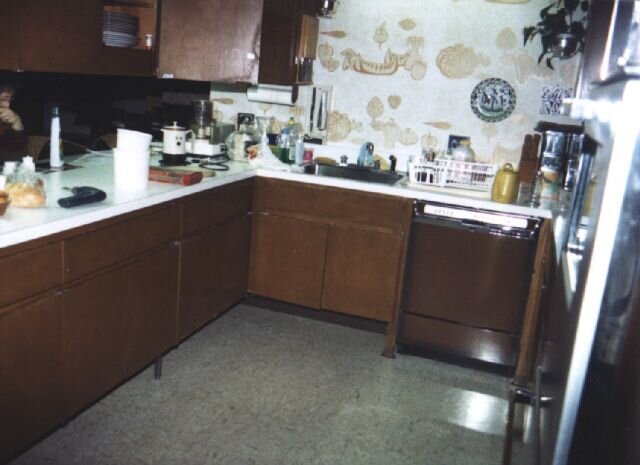Painting kitchen cabinets with HVLP spray equipment
More inspiration — I hope — for your own use of Fuji HVLP spray equipment, with information and text from my long career as a professional refinisher. Feel free to call me with your questions!
These kitchen cabinets were very dark
Painted kitchens have been very popular for a number of years now. Painting a kitchen has many advantages; major defects in the existing cabinets can be easily covered in the painting process, handles or knobs can be moved to a new location, whereas that would not usually be possible when a kitchen is stained.
Also a kitchen painted white or off-white will seriously brighten a dark room, give a cleaner and more spacious look. Painting a kitchen (all painted finishes are sprayed on with modern HVLP spray equipment) can be less expensive than staining and easier to touch-up when those inevitable nicks and dings occur through normal wear and tear.
Formerly dark kitchen after spraying paint on the cabinets
In most situations chemical stripping of all the existing finish is not necessary to paint cabinets, if the original finish is sound. An excellent chip resistant finish can be obtained by cleaning and vigorously sanding the existing finish before priming with "Bin". Of course if the existing finish is not sound it will need to stripped down to the bare wood before priming. My many years of experience makes it possible for me to readily determine the quality of an existing finish.
Many people ask me about a painted finish, "will it chip?" Most of the time when people ask me this question they are thinking about an experience they had or someone they know has had with a painted finish that readily chips, invariably this is caused by poor preparation of the surface to be painted over. I guarantee my painted finishes against spontaneous chipping due to improper preparation. Of course any finish if hit hard enough will ding and chip.
More examples of cabinets painted with HVLP spray systems
These cabinets were sprayed white over the old finish
Another kitchen with white cabinets thanks to Fuji HVLP paint spray system
Closeup of cabinets spray painted white with Fuji HVLP equipment
You can also apply a glaze over the sprayed paint, then protect it all by spraying it with a clear finish. This is a taupe glaze over an off-white paint. The molding enhances the effect of the glaze.
Both paint and final clear finish were sprayed with HVLP spray system.





